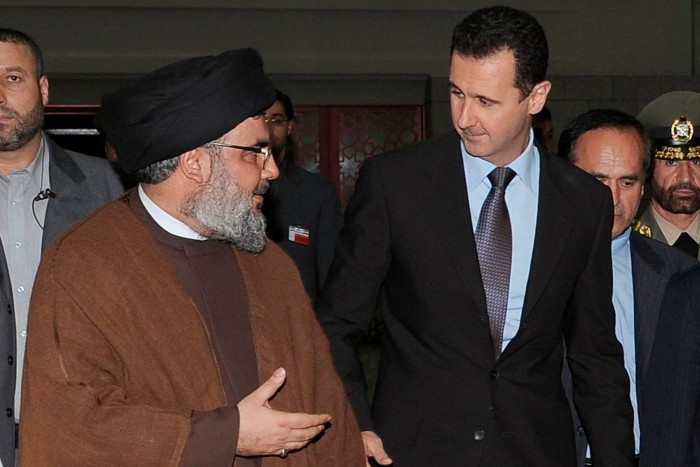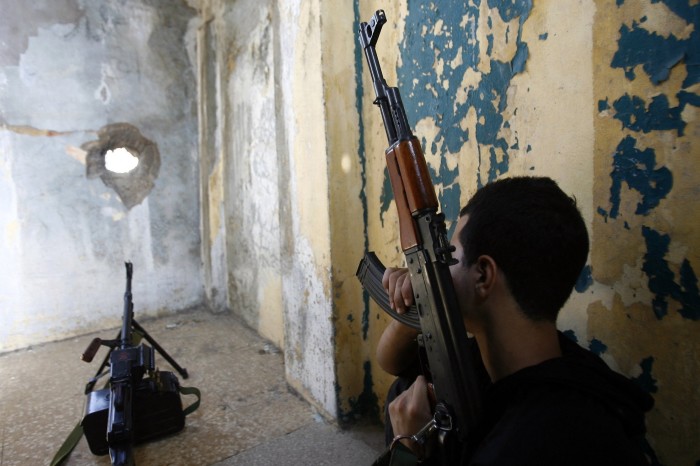
The crowds filling the town square in rebel-held north-west Syria were ecstatic, honking car horns, letting off fireworks and shooting guns in the air. They were celebrating an assassination: that of Hassan Nasrallah, the leader of Hizbollah and a sworn enemy of the Syrian opposition.
“We are celebrating the death of the despicable one,” a man yelled to a local journalist over the hubbub in jihadi-controlled Idlib, the last bastion of Syrian opposition. “He did a lot to us . . . Everyone from old to young is happy”. Another cried with joy.
Nasrallah, the leader of the Iran-backed Shia militant group, was killed in an Israeli air strike on Friday in Beirut, nearly a year after his group started launching rockets into Israel to support Hamas following its October 7 attack.
But the victorious atmosphere in Idlib was a reminder of how Hizbollah had also intervened in other conflicts across the Middle East, most notoriously fighting alongside Syrian dictator President Bashar al-Assad for more than a decade.
The decision to expand from its traditional territory of south Lebanon and enter Syria’s civil war was transformative for Hizbollah. It turned the militant group from a movement focused on resisting Israel from Lebanon into an attacking overseas force and a regional arm of Iran’s Revolutionary Guards’ overseas Quds Force.
The war in Syria also damaged Hizbollah, analysts said. It pitted it against fellow Muslims, eroding support among Sunnis and others around the Middle East who came to see it as a sectarian force propping up a hated dictator. Getting mired in a still unresolved war in Syria also overstretched the group, sowing the seeds for its current calamitous losses at the hands of an emboldened and untrammelled Israel, its original foe.
“Hizbollah’s role started to change”, said Hanin Ghaddar, a senior fellow at The Washington Institute. “They were no longer a Lebanese resistance group. They became Quds force’s regional arm.”
For Assad, Hizbollah’s support was crucial. With backing from Iran and Russia, it helped him keep control of fractured Syria and crush all but small pockets of resistance such as Idlib, now packed with millions displaced from former opposition areas that Hizbollah fought to return to Assad’s control.
When Assad brutally put down mass protests and civil war broke out in Syria in 2011, Nasrallah was faced with a difficult choice: potentially lose the friendly, Iran-aligned Assad regime to a likely hostile Sunni opposition government, or enter the battle and protect Hizbollah’s supply lines of weapons from Iran. He eventually decided to deploy about 10,000 men in the neighbouring country, according to multiple analysts, a significant amount of the group’s fighting force.
Supporters of Hizbollah argue that it helped push back the jihadist militant groups that had emerged from the wreckage of Syria’s opposition forces. The most powerful was Isis, which ultimately over-ran entire cities in eastern Syria and Iraq before being defeated by a US-co-ordinated coalition.

But critics blame the Shia militants for turning Syria’s civil war into a sectarian battle between Muslims. Most of Syria’s opposition is Sunni, the country’s majority sect, while Assad is Alawite, an offshoot of Shiism. Opposition media reported Hizbollah militiamen and regime soldiers had attacked villages in Idlib just last week.
“[Hizbollah] did all these ugly things,” said Bassam Barabandi, a former Syrian diplomat under the Assad regime who defected to the opposition. “They made it a sectarian war, 100 per cent.”
Backing the Syrian dictator, who had been expelled by the Arab League and at the time was reviled around the Arab world, was an enormous gamble for Nasrallah. It expended much of the goodwill he had earned from withstanding a month-long Israeli offensive in 2006, when the group was widely praised for defying Israel and seen as victorious.
Randa Slim, a programme director at the Middle East Institute in Washington, said Hizbollah officials she has spoken to knew that joining Assad would hurt their image, but believed that they would be able to restore their credibility in the next war with Israel: “Part of them, I think, believes this [current Gaza] war has helped them regain that goodwill . . . throughout the Arab publics.”

Analysts also said that Hizbollah’s victories in Syria appeared to artificially boost Nasrallah’s belief in his group’s military prowess, an attitude that Mohanad Hage Ali at the Carnegie Center in Beirut said was evident from his speeches.
While Hizbollah gained valuable battleground experience in Syria, fighting disparate rebel groups with no air power did only so much to prepare them for the might of Israel’s armed forces.
“This faux sense of military strength . . . was probably based on his Syrian experience again but it overlooked the fatigue impact,” Hage Ali said. “Fighting a war in south Lebanon for 30 to 40 days is one thing. Fighting a war for six to seven years in Syria is something else.”
Some analysts also argue that Hizbollah’s regional role for Iran, which included training and logistics support to Iran’s other proxy forces in Yemen and Iraq, may have helped distract Nasrallah’s commanders from their traditional focus on the Israeli front.
It “neglected the Israeli border while Israel was focusing on them,” said Ghaddar. “Israel was looking at Hizbollah as a priority, but Hizbollah was distracted by Syria.”
Hizbollah is now at its weakest point. Assad has so far been conspicuously silent about Nasrallah’s death, and the group’s members are under an unprecedented assault.
Southern Beirut’s Dahiyeh district, where Hizbollah had made its headquarters but which is densely packed with civilians, has been relentlessly targeted by Israeli air strikes. Dozens of civilians have been killed as well as Hizbollah commanders. Streams of Lebanese refugees, many of whom are Shia with Hizbollah members in their family, are heading for the Syrian border.
But Hizbollah’s investment in Syria may yet provide a lifeline. Years of fighting in the country allowed it to create a new stronghold outside Lebanon to which its fighters’ families can retreat, in the Damascus neighbourhood surrounding the important shrine to Sayyeda Zainab, the daughter of Ali, the first Shia Imam.
The area has “become more like Dahiyeh . . . They did build roots,” Ghaddar said, establishing religious centres and schools. “But they haven’t gone as deep as in Lebanon.”